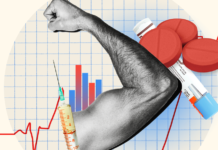But they’re also signs of low testosterone. Guys’ levels of the hormone naturally drop about 1 to 2 percent every year after 40, which can cause symptoms including low libido, erectile dysfunction, unexplained anemia, insomnia, depression, and a general loss of vigor, or mental and physical energy.
Since low T takes a simple blood test to confirm (you take the test twice), any guy who’s newly feeling these symptoms should ask their doctor about getting their testosterone tested, says Rajiv Jayadevan, MD, assistant clinical professor of urology and male fertility expert at The Men’s Clinic at UCLA Health.
What Is a Testosterone Test?
The most reliable way to test your hormonal levels is via a blood test. Skip the saliva tests—that only measures free testosterone, which comprises about 2 percent of your total T levels, explains andrology expert Charles Welliver, MD, associate professor of urology at Albany Medical College.
Instead, the blood test looks for your total testosterone levels, which counts free T as well as that bound to the proteins sex hormone-binding globulin (SHBG) and albumin.
Additionally, your doctor might want to test your SHBG-bound testosterone and your bioavailable T (that’s your free and albumin-bound testosterone). That’s because sometimes your total T can be in the healthy range, but one of these subcategories can be low, which would explain your symptoms but change your treatment, Dr. Jayadevan says.
But regardless, your doc will always test your total testosterone when checking if you’re dealing with low T.
What levels are considered healthy are somewhat variable, but levels below 264 or 300 nanograms per deciliter (ng/dL) are considered low.
That being said, some research has found that guys can have clinically low levels and not experience any symptoms, in which case having low T wouldn’t be cause for treatment at this point, Dr. Jayadevan explains.
Do You Really Need a Testosterone Test?
A lot of guys get a prescription for testosterone replacement therapy (TRT) without having their current levels tested, especially if they’re only seeing a primary care doctor and not a specialist like an endocrinologist or urologist. Dr. Jayadevan adds that he sees guys every week who got a testosterone gel or injections from the internet. You really need a test first, doctors stress.
When given appropriately, TRT can improve all aspects of sexual function, as well as help reduce fat and increase lean muscle mass in guys with hypogonadism.
But TRT also comes with risks, namely that it causes your pituitary gland to stop producing its own testosterone and, in many cases, causes your sperm production to hit zero or close to it. In other words: It tanks your fertility. Dr. Jayadevan adds that the guys that come into his office with prescriptions from the internet often don’t know this.
There are many reasons you should advocate for a blood test: For starters, a blood test can reveal nuanced markers that might point to the real culprit of your symptoms, which a TRT prescription won’t fix. For example, the problem might not be in the testicles, as with hypogonadism, but could actually be in the signaling pathway from the pituitary gland, Dr. Jayadevan explains.
Even if the root of the problem is in the testicles, other treatments might be a better first step for you than TRT. “Exercise and diet have an impressive effect on T levels,” Dr. Welliver adds.
Moreover, it’s also important to know if your T levels are clinically low, as that can be tied to other health risks that you’ll want to pay attention to, particularly related to your heart.
When Should You Get a Testosterone Test?
“A morning blood test before 10 a.m. is the gold standard [for testing testosterone levels accurately],” says Dr. Welliver. That’s because your T levels are highest in the morning.
You’ll likely want a second round of testing to confirm those results: There is roughly a 25 percent variability in testosterone testing in the same person week-to-week or even day-to-day, Dr. Welliver says. You may also want a second test if your total T was borderline and the doctor wants to confirm whether your symptoms are tied to one of the more nuanced markers like SHBG, bioavailable, or free testosterone.
As for when in life should you get tested: The primary reason to get a T test is if you feel symptoms, namely decreased energy or decreased libido, although your doc might suggest it if you have another disease that predisposes you to or indicates low T, such as osteoporosis, diabetes, or HIV.
However, some doctors, like Dr. Jayadevan, like their patients to get a baseline test in their 20s. “Ideally, I’d have your T levels from your mid-20s when everything was working perfectly—your libido was great, erections were good, your ability to put on muscle wasn’t impaired—to have as a point of comparison for later on,” he explains.
Let’s be clear: Getting your total T levels tested when you’re asymptomatic and healthy serves no purpose beyond potentially shedding light for your future self.
Your asymptomatic test could come back low—even though people function at a “low normal” without any symptoms all the time, Dr. Jayadevan explains, knowing you have naturally low testosterone can mess with some guys’ heads.
And your doc isn’t going to give you treatment at this stage—because you don’t need it: Dr. Jayadevan adds that he would never recommend someone at a “low normal” to raise their testosterone “because they function so well at their natural levels.”
In other words: Low T is only a problem if it’s causing symptoms before you knew the number.























